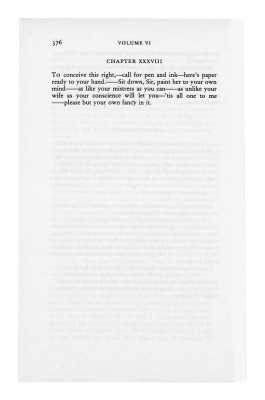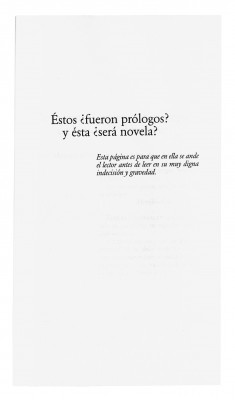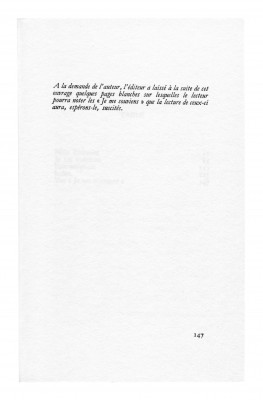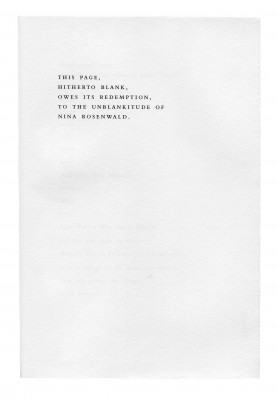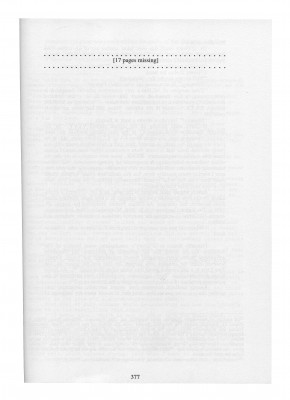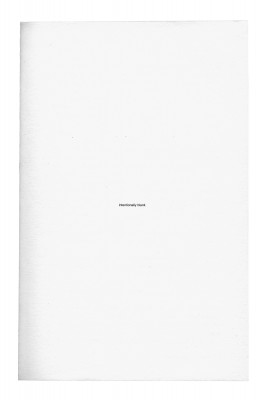On Blank Pages
In the prologue to The Midnight, Susan Howe makes reference to the tissue interleaf that bookbinders used to place between frontispiece and title page, "in order to prevent illustration and text from rubbing together." Her words are preceded by a full-bleed photograph of the interleaf in an old copy of Robert Louis Stevenson’s The Master of Ballantrae, through which the original title page can be made out. On the reverse of the page, a mirror image of the photograph signals to the reader that he's passed through the looking glass; the blurred, backward words serve as "a whisper and a stage direction." The Midnight is an elegy written by a self-declared insomniac, a dense composition of erudite prose, staccato poetry, and photographs of inherited books, of partially obscured frontispieces and title pages. Howe writes: "Although a sign is understood to be consubstantial with the thing or being it represents, word and picture are essentially rivals. The transitional space between image and scripture is often a zone of contention." In the following pages I will explore several examples of such zones of contention. In each instance, the conventional layout of a passage of prose is interrupted by a significant blank space, an absence of words embedded among uniform rows of typeset words.
"Mischief," Howe writes, "delights in playing with surfaces."
The Life and Opinions of Tristram Shandy, Gentleman
In volume six of Laurence Sterne's The Life and Opinions of Tristram Shandy, Gentleman, a blank page is presented to the reader so that he can paint a desirable woman according to his own preferences, "as like as your mistress as you can – as unlike your wife as your conscience will let you." Sterne employs this device in order to convey to the reader uncle Toby's strong attraction to Mrs. Wadman. On the next page he writes: "Was ever any thing in Nature so sweet! – so exquisite! – Then, dear Sir, how could my uncle Toby resist it?" By now, the reader has become accustomed to Sterne's irreverent, discursive style: in volume one a black page commemorated the death of a character; in volume three a marbled page emblematized the unique, unpredictable nature of life; and scattered throughout the text are dashes of various length and suggestive rows of asterisks.
In volume nine, the reader is confronted with two blank pages in place of chapters 18 and 19, respectively. At the beginning of chapter 25 Sterne writes: "When we have got to the end of this chapter (but not before) we must all turn back to the two blank chapters, on the account of which my honor has lain bleeding this half hour …. I look upon a chapter which has, only nothing in it, with respect; and considering what worse things there are in the world – that it is no way a proper subject for satire – Why then was it left so?" He ends chapter 25 by answering his own question: "All I wish is, that it may be a lesson to the world, ‘to let people tell their stories their own way.'" Then Sterne, who has left the reader waiting in suspense for long enough, inserts the two missing chapters: uncle Toby, it transpires, had finally gathered the courage to declare his love for "sweet, exquisite" Mrs. Wadman.
In the original edition of Tristram Shandy, published in installments between 1759 and 1967, the blank chapters are blank pages; in some later editions, such as those published by Airmont (1967) or the Modern Library (1940), the blank pages have been transformed into small, arbitrary areas of blank space. The Airmont edition even does this to the blank page in volume six, rendering it all but unusable as a canvas. Visual Editions's Tristram Shandy (2011) goes so far as to illustrate the blankness: an empty, varnished portrait oval adorns the blank page in volume six; and long red arrows cover the blank pages in volume nine, pointing the reader to the chapters' actual location.
This last edition calls to mind a remark by Lydia Davis: "I tried, once, for fun, translating Laurence Sterne into more contemporary English. It worked to some extent – some of the narrative content was preserved, some of the humor, quirkiness, etc. – but it was painful. Each time I abandoned some phrasing of his in favor of an 'updated' version, an essential, delightful peculiarity of the work was lost."
The Hunting of the Snark
In Lewis Carroll's The Hunting of the Snark, which chronicles "with infinite humor the impossible voyage of an improbable crew to find an inconceivable creature," the Bellman has a map to navigate across the ocean. Carroll writes: "He had bought a large map / Without the least vestige of land: / And the crew were much pleased when they found it to be / A map they could all understand. / 'What's the good of Mercator's North Poles and Equators, / Tropics, Zones, and Meridian Lines?' / So the Bellman would cry: and the crew would reply / 'They are merely conventional signs! / Other maps are such shapes, with their islands and capes! / But we've got our brave Captain to thank' / (So the crew would protest) 'that he's bought us the best – / A perfect and absolute blank!'" The crew reaches its destination, a strange land that may well be inhabited by so-called Snarks, in spite of (or perhaps thanks to?) the Bellman's blank sheet of paper. At the end of the poem, the Baker succeeds in finding a Snark, which tragically proves to be a so-called Boojum, and "softly and suddenly" he vanishes into thin air, never to be met with again.
At the beginning of Georges Perec's Species of Spaces, an attempt to investigate the subject of space from all angles, the map of the ocean from The Hunting of the Snark is juxtaposed with a list of potential spaces. "The subject of this book," he writes, with reference to the map, "is not the void exactly, but rather what there is round about or inside it. To start with, then, there isn't very much: nothingness, the impalpable, the virtually immaterial; extension, the external, what is external to us, what we move about in the midst of, our ambient milieu, the space around us." Naturally, he starts his investigation with the space of the page. He writes: "Before there was nothing, or almost nothing; afterwards, there isn't much, a few signs, but which are enough for there to be a top and a bottom, a beginning and an end, a right and a left, a recto and a verso." In short, there's sufficient information to enable the reader to orient himself, there's a defined space across which the reader can navigate.
Curiously, Henry Holiday's illustration of the blank map for the first edition of The Hunting of the Snark does make use of cartographic terms, including the equator, North Pole, and South Pole. Perec's map makes no such use of terms; it simply delineates a (square) blank space. "This is how space begins," Perec writes, "with words only, signs traced on the blank page."
The Museum of Eterna's Novel
In the last of the interminable prologues that make up the best part of Macedonio Fernández's The Museum of Eterna's Novel (The First Good Novel), which he wrote concurrently with Adriana Buenos Aires (The Last Bad Novel), the author makes reference to the "marked out – traditional – structure – of – literary – binding" that his Editors – that is, the collective archetype of a literary editor – have imposed. The book, part metaphysical allegory, part fragmentary disquisition on the novel as a literary form, is dedicated to the so-called Skip-Around Reader, who, Fernández writes, should be grateful to him "for a new sensation: reading in order" (conversely, "the orderly reader will experience a new way of skipping: the orderly reading of a skipping-around author"). His final stratagem to postpone the novel proper is to request that his Editor insert four or five blank pages, so that he can replace these pages with a four-to-five page critique of "the blank." In every novel, Fernández observes, there are a number of blank pages – "texts that disdain the literary" – that are essentially the Editor's preserve: four or five at the beginning of the novel; four or five at the end, "as if the novel had to continue, if only in blanks"; various pages between chapters; one with the title of the novel; one that repeats the cover design; and "all sorts of abuses of margins." In short, a novel has approximately 20 blank pages, "where the author isn't publishing a thing and the continuous reader has purchased nothing at the bookstore."
He writes: "I repudiate all the blank pages published here as forgeries, that is, originals bearing my signature; actually I don't know if they are authentic, although they do partially contain something ingenious or some thought, and some editor would even have you think that one of them sprang from my own pen in correlation with certain moments of mental 'blankness.'" To which his Editor responds: "Permit me to assert the response that, in effect, the great novelist that I edit here, and whose talents of genius and facile extension of paragraphs the public has known from afar (with our marketing, he'll get closer), has necessitated (I'm not talking here of monies) at times, when I was fed up with his literature, the insertion of a few blank pages, bound in folio, from some short story, and we understood that this constituted an extra-contractual practice."
After this last pre-novelistic observation, the reader is presented with a blank page – under the heading "WERE THOSE THE PROLOGUES? AND IS THIS THE NOVEL?" – "to linger, in his well-deserved and serious indecision, before reading on."
I Remember
In the early 1970s Harry Mathews told Georges Perec about Joe Brainard's I Remember, in which the author, already distinguished as a visual artist, catalogs his memories of growing up. Each of the more than 1,000 short, discrete paragraphs begins with the phrase "I remember." For example: "I remember the first time I got a letter that said 'After Five Days Return To' on the envelope, and I thought that after I had kept the letter for five days I was supposed to return it to the sender." Or: "I remember a dream of meeting a man made out of very soft yellow cheese and when I went to shake his hand I just pulled his whole arm off."
Mathews's account proved somewhat inexact; shortly afterward, Perec began his own I Remember, a less intimate work than Brainard's. Perec, too, catalogs his memories of growing up, but he adopts a more impersonal tone, focusing on collective memories, on what he termed the infra-ordinary: "the banal, the quotidian, the obvious, the common, the ordinary." For example: "I remember that Ciroën used the Eiffel Tower for a gigantic illuminated advertisement." Or: "I remember that de Gaulle had a brother called Pierre who ran the Foire de Paris." Perec's "I remembers" are about things that had ceased to exist; consequently, he feels obliged to acknowledge certain inaccuracies or gaps. "When I evoke memories from before the war," he writes, "they refer for me to a period belonging to the realm of myth: this explains how a memory can be 'objectively' false."
Unlike Brainard, who delights in the associative quality of memory, Perec numbers his entries and provides an index. The last entry, memory 480, reads "I remember (to be continued …)." To emphasize the communal aspect of his memories, Perec requested that several blank pages be inserted after the index, "so that the reader can record his or her own 'I remembers.'"
1982, Janine
At the climax of Alasdair Gray's 1982, Janine, Jock McLeish, the alcoholic installer of security systems whose elaborate pornographic fantasies take up much of the novel, descends into a Scotch- and pill-induced delirium. "I am in chaos," he says, "I am sick, my head is full of rubber bullets, my head is full of snow and it's melting, my head is full of wee boats and they're all sunk, my head is full of Reichstags and they're all burning, my head is crammed with engines doing different things at different speeds (you can't control them) I CAN'T CONTROL THEM QUICK GRAB JUMP ASTRIDE ASTRIDE ASTRIDE THE NEAREST CLING LIKE GRIM DEATH TO BIGGEST FASTEST LOUDEST GOING DUNGDUNGDUNGDUNGDUNGDUNGDUNGDUNG …."
The next eight pages bring together four distinct narrative voices in a chaos of dense, experimental typography. Gray explains: "On one margin the voice of his body complains of the feverish temperature he's condemned to, while in the middle his deranged libido fantasizes and alternates with his deranged conscience denouncing him for having such fantasies. On the other margin, in very small print, the voice of God tries to tell him something important, tell him he has missed the point of living in a voice he can hardly hear, because it is not thunderously denouncing." Suddenly McLeish vomits, after which the delirious voices subside. Then the narrative voice becomes sluggish, the prose fragmented and subject-less. "To bed," the author writes. "Lie down. Slip under sheet."
Once in bed, McLeish falls asleep, which Gray represents by inserting four blank pages, an absence of words that serves as a restful counterpoint to the overwrought sequence chronicling his failed suicide attempt ("How long till coma and zero?" he'd asked himself). On waking, the text resumes, and McLeish composes himself. "What shall I do with my mind?" he asks. "What story is left for me to tell?"
Arcade, or How to Write a Novel
The flap copy of Gordon Lish's Arcade, or How to Write a Novel describes the book, which is narrated by an elderly writer named Gordon Lish, as "empty, the pursuit of a blank, a smug admission of flawed booklessness." Throughout the book, the narrator's protracted attempts to relate a handful of childhood memories as precisely as possible are hindered by the gaps in his memory. For instance, he remembers walking up to the steps of a bungalow, but is unsure as to whether he climbed the steps with or without assistance. "Neither am I in a position to say what the situation was in regards to the porch," he adds. "This is another blank. The porch is another blank!" Such trivial details repeatedly bring the text to a halt. "Okay, there are blanks," he admits. "Granted, granted, there is the existence of, you know, of blanks."
Lish's candor turns spiteful, and he decides to leave certain things out on purpose, to "teach you people a lesson about this constant ceaseless vicaritude." Suddenly the text breaks off in mid-sentence. The next 21 pages are left blank – apart from the running heads and page numbers – after which the text resumes where it left off, at the exact same location on the page. Several pages later, the text again breaks off in mid-sentence, which is this time followed by 12 blank pages – with page numbers but without running heads. Lish boasts about "not even putting anything on the pages when I Gordon just don't happen to feel like putting anything on the pages!" He even considers titling the book Towards a Better Blank. When the text breaks off in mid-sentence for a third time, it is for seven blank pages – without page numbers nor running heads but with a small dot in the upper corner of each page. When it happens for the fourth, final time, it is for four completely blank pages. The narrator's memories may or may not be factual, the reader realizes, his omissions may or may not have substance. In the brief chapter "How to Write a Novel," Lish, the well-known editor, wryly concludes, "Work on your blanks."
At the end of the novel, the author makes reference to a formerly blank page by way of cryptic homage. "This page," he writes, "hitherto blank, owes its redemption, to the unblankitude of Nina Rosenwald."
House of Leaves
Mark Z. Danielewski’s House of Leaves makes extensive use of full-color printing, topsy-turvy page layouts, unconventional typography, and photographs. At times, the reader is presented with several narrative levels, not to mention reading directions, on a single page; at times, he is presented with extensive blank space. House of Leaves revolves around a documentary called The Navidson Record. Just as the book's characters explore the film's setting, so the reader explores the oversize, squarish pages of the book itself. Indeed, the distinction between these two spaces collapses at various points in the novel. For example, in the sentence "But if Navidson is no longer holding onto the rope, what could possibly be pulling Reston to the top?" the last word is isolated at the upper right corner of the page, thus designating both the top of a stairway and the top of the page itself.
The book is a patchwork of various documents relating to the film and people's commentary thereon, some of which contain gaps indicated by empty parentheses or deliberate blank spaces. "Some kind of ash landed on the following pages," the narrator explains, in reference to one such document, "in some places burning away small holes, in other places eradicating large chunks of text. Rather than try to reconstruct what was destroyed I decided to just bracket the gaps." Shortly afterward, an editor comments on an extended gap in the text. "Inexplicably," he writes, "the remainder of this footnote along with seventeen more pages of text vanished from the manuscript." The next page indicates this omission with the bracketed note, "17 pages missing."
Appropriately, many of the typographic devices in House of Leaves have a cinematic feel. When The Navidson Record abruptly ends, the narrator announces, "The film runs out here, leaving nothing else behind but an unremarkable white screen." These last two words are spread out across four pages: the first page has the word "white" at its optical center; the next page is blank; the next page has the word "screen" at its optical center; and the final page has an enlarged period at its optical center, marking the end of the documentary but not its rebus-like exegesis, which threatens to overflow the book's 700-plus pages.
JPod
The main characters in Douglas Coupland's JPod are designers at a video game corporation who spend most of their time sending each other emails and riffing on popular culture. The book's layout is similar to that of Coupland's earlier Microserfs: the conventional, sitcom-like narrative is interleaved with typographically bold pages of random lists, endless rows of numbers, and humorous takes on commercial slogans. At one point in the book, knowing reference is made to the characters in Coupland's first novel, Generation X, who "were all twenty-something slackers looking for meaning in life." (The letter X in Generation X is "a placeholder, a variable or blank to be filled in later.") Similarly, the characters in JPod are directionless. "I scoured my life and saw no overriding purpose," the narrator says, "just my love affair with computer games."
Workaholism and pop culture are, it seems, the panaceas for these characters' existential doubt. At the beginning of the book, a dense page of spam and banal observations includes the question, "Don't you get an empty feeling in your soul when you have a blank to-do list?" The characters in JPod are "mildly autistic: poor social skills, the ability to obsess on anything numerical or repetitive, the odd outfits, the paranoia and the sense of continually being judged and measured." In addition, they shy away from actual physical contact. When the topic of books comes up, one character, Mark, admits to not reading novels. "Mark's an emotional blaaaaank," another character jeers. "Mark's an emotional blaaaaank."
When the video game the characters have been working on is abruptly killed, most of them simply move on. One of them says, "It's as if the game never existed." To which the narrator replies, "I had to agree. I felt … blank. Just blank." The next page resembles a blank page in a corporate or legal document, redundantly labeled, "intentionally blank."
The Easy Chain
The email on the back cover of Evan Dara's The Easy Chain describes the novel as follows: "Lincoln Selwyn, a young Briton, set Chicago ablaze. Over the last nine months, this charismatic blond with the irresistible accent vaulted to the top of the city's social hierarchy, slept with the majority of its first daughters and racked up an unimaginable fortune. And then he ."
The first half of the book is a cacophony of unidentified voices talking about Selwyn in glowing terms. These voices, however, are omniscient, so their speech is an odd mixture of gossip, exposition, and shaggy-dog stories. Selwyn's character is created entirely out of others' impressions of him. He's described as "pure, invincible presence," but for the reader he never fully comes into focus. Throughout the novel, Dara makes reference to lacunae: voices trail off into silence, a children's book author mentions the blank pages in her book, a man curates "an exhibition on the holography of negative space." At the height of his fame, Selwyn disappears, and consequently the voices stop talking. 45 blank or nearly blank pages represent his mysterious absence. (The occasional French-style speech dash and the word "you" signal the lingering presence of the voices.) Then the text resumes bit by bit: "Well, I heard," "I mean I understood," "I understood he was in Lexington …."
The second half of the book is a mix of styles that tells the story of Selwyn's travels to Europe and his eventual return to Chicago. A team of hard-boiled criminal investigators and a ditzy journalist attempt to find him, without success. Several blank pages interrupt an extended passage of obsessively repetitive poetry. At the end of the book, Selwyn takes a job as a custodian at the Chicago Mercantile Exchange, which he intends to sabotage. Just before he detonates an explosion, a man recognizes him and says, "Linc, that you …?" For the first and only time in the novel, Selwyn is given a voice, and he says, " ."

















